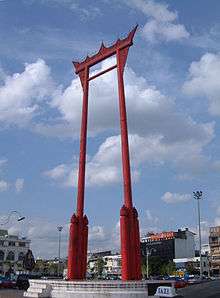Giant Swing

The Giant Swing (Thai: เสาชิงช้า, rtgs: Sao Chingcha, pronounced [sǎw t͡ɕʰīŋ.t͡ɕʰáː]) is a religious structure in Phra Nakhon, Bangkok, Thailand. Located in front of Wat Suthat, it was formerly used in an old Brahmin ceremony, and is one of Bangkok's tourist attractions.
History
The Giant Swing was constructed in 1784 in front of the Devasathan shrine by King Rama I. During the reign of Rama II the swing ceremony was discontinued as the swing had become structurally damaged by lightning. In 1920 it was renovated and moved to its current location in order to make space for a gas plant. The ceremony was again performed until 1935, when it was discontinued after several fatal accidents.
The last renovations were done in 1959, and after 45 years of exposure to the elements the wooden pillars were showing signs of serious damage. A major reconstruction began in April 2005. Six teak tree trunks were used. The two used for the main structure of the swing are over 3.5m in circumference and over 30m in height. The remaining four are used for support and are 2.30m in circumference and 20m in height.[1] The swing was taken down in late October 2006 and the work finished in December of the same year. The rebuilt swing was dedicated in royal ceremonies presided over by His Majesty King Bhumibol Adulyadej in September 2007. The timbers of the original swing are preserved in the National Museum.
In 2005, the Giant Swing, together with Wat Suthat, was suggested as a future UNESCO World Heritage Site.
The important places around the Giant Swing
Wat Suthat Thep Wararam
Wat Suthat Thep Wararam, commonly shortened to “Wat Suthat”, is an important temple in Thailand. Inside the Grand Hall has a Phra Sri Sagaya Munee, its principle Buddha image which was acquired from Wat Mahathat in Sukhothai. Wat Suthat was built by the King Rama 1 in the center of his capital but it was completed in the reign of Rama 3.[2] Many people often make pilgrimages to worship the Buddha especially on holy days such as Visakha Bucha Day, Magha Bucha Day etc.
SarnChoa Po Seu
In the quarter there is also a well known and high regarded Chinese shrine, Sarn Choa Po Seu (the Tiger Shrine.) Originally it was a big building located on Bamrungmueng Road where the big Chinese communities were. Later on, King Rama 5 would like to expand the road therefore had the shrine relocated to the current location on Ta Nao Road near WatMahanaparam.[3] The site is a place of worship for Thai and the Chinese people seeking success in career, money, love, and infant fertility.
LanKonMueng
At the heart of the quarter is LanKonMueng in front of the City Hall. Every evening, this is the recreational area of the locals where they can exercise such as dance aerobics, jogging, stroll around, gather or just relax, bring children or pets out for a walk and enjoy the breeze.[4]
Swing ceremony
An annual swinging ceremony known as Triyampavai-Tripavai was held at Giant Swings of major cities until 1935, when it was abolished for safety reasons.[5] The name of the ceremony was derived from the names of two Tamil language Hindu chants: Thiruvempavai (a Shaivite hymn by Manikkavacakar) and Thiruppavai (a Vaishnavite hymn by Andal). Among Thai people, the ceremony was popularly known as Lo Jin Ja or Lo-Chin-Cha ("pulling the swing"). It is known that Tamil verses from Thiruvempavai — poet pratu sivalai ("opening the portals of Shiva's home") — were recited at this ceremony, as well as the coronation ceremony of the Thai king.[6] According to T.P. Meenakshisundaram, the name of the festival indicates that Thiruppavai might have been recited as well.[7]
According to an ancient Hindu epic, after Brahma created the world he sent Shiva to look after it. When Shiva descended to the earth, Naga serpents wrapped around the mountains in order to keep the earth in place. After Shiva found the earth solid, the Nagas moved to the seas in celebration. The Swing Ceremony was a re-enactment of this. The pillars of the Giant Swing represented the mountains, while the circular base of the swing represented the earth and the seas. In the ceremony Brahmins would swing, trying to grab a bag of coins placed on one of the pillars.
See also
- Torii, similar in appearance but with different purposes
References
- ↑ Daily News - Manager Online
- ↑ ThammaThai “WatSuthat” Retrieved 19th October 2013, http://www.dhammathai.org/watthai/bangkok/watsutat.php, 2013
- ↑ Travel “PaiWaiSarnJaoPorSeu” Retrieved 19th October 2013, http://travel.kapook.com/view8796.html, 2013
- ↑ Travel “Sao ching cha” Retrieve 18th October 2013, http://www.manager.co.th/travel/viewnews.aspx?NewsID=9560000034732, 2013
- ↑ M. E. Manickavasagom Pillai (1986). Dravidian Influence in Thai Culture. Tamil University. p. 69.
- ↑ Upendra Thakur (1986). Some Aspects of Asian History and Culture. Abhinav. pp. 27–28. ISBN 978-81-7017-207-9.
- ↑ Norman Cutler (1979). Consider Our Vow: Translation of Tiruppāvai and Tiruvempāvai Into English. Muttu Patippakam. p. 13.
External links
- Information from the Bangkok Tourism Division
- Newspaper article on the 2005 restoration
- Brahminism in Thailand
- 2Bangkok on the 2005 renovation
Coordinates: 13°45′7″N 100°30′5″E / 13.75194°N 100.50139°E
| Wikimedia Commons has media related to Giant Swing. |